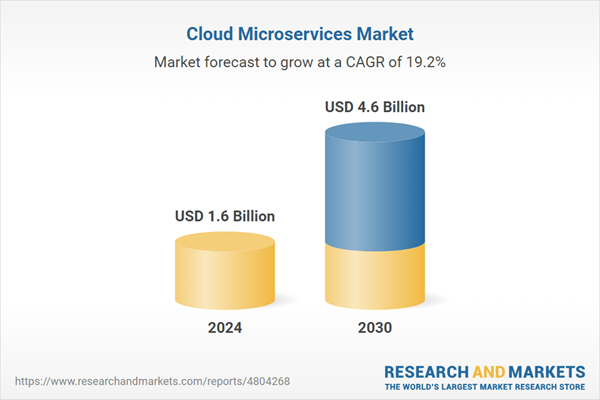The global market for Cloud Microservices was valued at US$1.6 Billion in 2024 and is projected to reach US$4.6 Billion by 2030, growing at a CAGR of 19.2% from 2024 to 2030. This comprehensive report provides an in-depth analysis of market trends, drivers, and forecasts, helping you make informed business decisions. The report includes the most recent global tariff developments and how they impact the Cloud Microservices market.
Segments: Component (Platform, Services); Deployment (Hybrid Cloud, Private Cloud, Public Cloud); End-Use (BFSI, Telecom, Government, Healthcare & Life Sciences, Retail & Consumer Goods, Manufacturing, Other End-Uses).
Geographic Regions/Countries: World; United States; Canada; Japan; China; Europe (France; Germany; Italy; United Kingdom; and Rest of Europe); Asia-Pacific; Rest of World.
The analysts continuously track trade developments worldwide, drawing insights from leading global economists and over 200 industry and policy institutions, including think tanks, trade organizations, and national economic advisory bodies. This intelligence is integrated into forecasting models to provide timely, data-driven analysis of emerging risks and opportunities.
Global Cloud Microservices Market - Key Trends and Drivers Summarized
How Are Cloud Microservices Revolutionizing Application Development?
Cloud microservices represent a paradigm shift in the way applications are developed, deployed, and managed. Unlike traditional monolithic architectures, where an application is built as a single, cohesive unit, microservices architecture breaks down applications into small, independently deployable services, each responsible for a specific function. These microservices communicate with each other via APIs and can be developed, deployed, and scaled independently of one another. In a cloud environment, microservices benefit from the scalability, flexibility, and distributed nature of cloud platforms. Each microservice can be hosted in its own container, allowing businesses to scale individual components of an application as needed without affecting the entire system. This modularity enables faster development cycles, as teams can work on different services simultaneously, reducing bottlenecks in the development process. Moreover, cloud microservices leverage the elastic nature of cloud resources, automatically scaling up during peak demand and down when demand decreases, optimizing resource usage and costs. This architecture is especially well-suited for modern, agile development methodologies and DevOps practices, allowing for continuous integration and delivery (CI/CD) in cloud-native environments.Why Are Cloud Microservices Becoming a Game-Changer for Businesses?
The adoption of cloud microservices is accelerating because they provide a more agile and resilient approach to application development and deployment. Businesses that rely on legacy monolithic systems often face challenges such as slow release cycles, difficulties in scaling specific parts of an application, and a lack of flexibility in responding to market demands. Cloud microservices offer a solution to these issues by allowing teams to build, test, and deploy individual services independently, speeding up the development process and reducing the risk of failures. This architecture enables continuous updates and improvements without the need to redeploy the entire application, making it easier for businesses to respond to evolving customer needs and industry trends. Additionally, cloud microservices are highly resilient. In a monolithic system, the failure of a single component can bring down the entire application, but with microservices, the failure of one service doesn’t impact the others. This isolation of services ensures better fault tolerance and improved uptime, which is critical for businesses that rely on high availability. For organizations looking to achieve rapid innovation and shorter time-to-market for new features, cloud microservices provide the flexibility and scalability required to stay competitive in a digital-first world.How Are Emerging Technologies and Practices Influencing Cloud Microservices?
Emerging technologies and modern development practices are significantly enhancing the capabilities and adoption of cloud microservices. Containerization is one of the key technologies enabling microservices, with platforms like Docker and Kubernetes providing the foundation for isolating and managing individual services. Containers allow microservices to be deployed consistently across different environments, ensuring that applications run the same in development, testing, and production environments. Kubernetes, in particular, has become the de facto orchestration tool for managing large-scale deployments of microservices, offering features like automated scaling, load balancing, and self-healing capabilities. Additionally, serverless computing is influencing the evolution of microservices by allowing developers to focus solely on writing code, without worrying about the underlying infrastructure. Serverless platforms like AWS Lambda and Google Cloud Functions take care of provisioning and scaling, making microservices even more lightweight and efficient. Another major influence is the rise of DevOps and agile methodologies, which emphasize continuous integration, testing, and delivery. Microservices align perfectly with these practices, enabling teams to work on small, independent services in parallel, fostering a culture of rapid innovation and constant iteration. As these technologies and practices continue to evolve, they are making cloud microservices more accessible and easier to manage, helping businesses fully leverage their benefits.What Are the Key Growth Drivers for Cloud Microservices Market?
The growth in cloud microservices adoption is driven by several factors, largely related to the need for more agile, scalable, and resilient application architectures. One of the most significant drivers is the increasing demand for rapid innovation and faster time-to-market for digital services. As businesses strive to meet the evolving needs of consumers, the ability to develop, test, and deploy new features quickly is paramount. Cloud microservices allow for modular development, where individual services can be updated and deployed independently, accelerating the release of new features and updates. Another key driver is the shift toward cloud-native architectures. As businesses migrate to cloud environments, they are rethinking how their applications are built and managed. Microservices are a natural fit for cloud platforms because they take full advantage of the scalability and flexibility that the cloud offers. In particular, the rise of multi-cloud and hybrid cloud strategies is pushing businesses to adopt cloud microservices, as they enable seamless integration and management across different cloud platforms. Cost efficiency is also a major factor, as cloud microservices enable organizations to optimize resource usage. Instead of scaling an entire application, businesses can scale individual services based on demand, which reduces unnecessary resource consumption and costs. Lastly, the demand for highly resilient and fault-tolerant systems is driving microservices adoption. By isolating individual components of an application, businesses can improve the reliability of their systems, ensuring that failures in one service do not impact the entire application. As businesses continue to prioritize agility, scalability, and resilience, the adoption of cloud microservices is expected to surge, making them a foundational element of modern application development.Report Scope
The report analyzes the Cloud Microservices market, presented in terms of units. The analysis covers the key segments and geographic regions outlined below.Segments: Component (Platform, Services); Deployment (Hybrid Cloud, Private Cloud, Public Cloud); End-Use (BFSI, Telecom, Government, Healthcare & Life Sciences, Retail & Consumer Goods, Manufacturing, Other End-Uses).
Geographic Regions/Countries: World; United States; Canada; Japan; China; Europe (France; Germany; Italy; United Kingdom; and Rest of Europe); Asia-Pacific; Rest of World.
Key Insights:
- Market Growth: Understand the significant growth trajectory of the Platform Component segment, which is expected to reach US$3.4 Billion by 2030 with a CAGR of a 20.9%. The Services Component segment is also set to grow at 15.1% CAGR over the analysis period.
- Regional Analysis: Gain insights into the U.S. market, valued at $439.4 Million in 2024, and China, forecasted to grow at an impressive 18.1% CAGR to reach $693.1 Million by 2030. Discover growth trends in other key regions, including Japan, Canada, Germany, and the Asia-Pacific.
Why You Should Buy This Report:
- Detailed Market Analysis: Access a thorough analysis of the Global Cloud Microservices Market, covering all major geographic regions and market segments.
- Competitive Insights: Get an overview of the competitive landscape, including the market presence of major players across different geographies.
- Future Trends and Drivers: Understand the key trends and drivers shaping the future of the Global Cloud Microservices Market.
- Actionable Insights: Benefit from actionable insights that can help you identify new revenue opportunities and make strategic business decisions.
Key Questions Answered:
- How is the Global Cloud Microservices Market expected to evolve by 2030?
- What are the main drivers and restraints affecting the market?
- Which market segments will grow the most over the forecast period?
- How will market shares for different regions and segments change by 2030?
- Who are the leading players in the market, and what are their prospects?
Report Features:
- Comprehensive Market Data: Independent analysis of annual sales and market forecasts in US$ Million from 2024 to 2030.
- In-Depth Regional Analysis: Detailed insights into key markets, including the U.S., China, Japan, Canada, Europe, Asia-Pacific, Latin America, Middle East, and Africa.
- Company Profiles: Coverage of players such as Amazon Web Services, Inc., CA Technologies, Inc., Contino Solutions Limited, IBM Corporation, Idexcel, Inc. and more.
- Complimentary Updates: Receive free report updates for one year to keep you informed of the latest market developments.
Some of the 26 companies featured in this Cloud Microservices market report include:
- Amazon Web Services, Inc.
- CA Technologies, Inc.
- Contino Solutions Limited
- IBM Corporation
- Idexcel, Inc.
- Infosys Ltd.
- Kontena Inc.
- Macaw Software Inc.
- Marlabs Inc.
- Microsoft Corporation
- Netifi Inc.
- NGINX Inc.
- OpenLegacy Inc.
- Oracle Corporation
- Pivotal Software, Inc.
- RapidValue Solutions
- Robomq
- Salesforce.com, Inc.
- SmartBear Software, Inc.
- Software AG
- Syntel, Inc.
- Tata Consultancy Services Limited
- Unifyed
- Weaveworks Inc.
Tariff Impact Analysis: Key Insights for 2025
Global tariff negotiations across 180+ countries are reshaping supply chains, costs, and competitiveness. This report reflects the latest developments as of April 2025 and incorporates forward-looking insights into the market outlook.The analysts continuously track trade developments worldwide, drawing insights from leading global economists and over 200 industry and policy institutions, including think tanks, trade organizations, and national economic advisory bodies. This intelligence is integrated into forecasting models to provide timely, data-driven analysis of emerging risks and opportunities.
What’s Included in This Edition:
- Tariff-adjusted market forecasts by region and segment
- Analysis of cost and supply chain implications by sourcing and trade exposure
- Strategic insights into geographic shifts
Buyers receive a free July 2025 update with:
- Finalized tariff impacts and new trade agreement effects
- Updated projections reflecting global sourcing and cost shifts
- Expanded country-specific coverage across the industry
Table of Contents
I. METHODOLOGYII. EXECUTIVE SUMMARY2. FOCUS ON SELECT PLAYERSIII. MARKET ANALYSISIV. COMPETITION
1. MARKET OVERVIEW
3. MARKET TRENDS & DRIVERS
4. GLOBAL MARKET PERSPECTIVE
UNITED STATES
CANADA
JAPAN
CHINA
EUROPE
FRANCE
GERMANY
ITALY
UNITED KINGDOM
REST OF EUROPE
ASIA-PACIFIC
REST OF WORLD
Companies Mentioned (Partial List)
A selection of companies mentioned in this report includes, but is not limited to:
- Amazon Web Services, Inc.
- CA Technologies, Inc.
- Contino Solutions Limited
- IBM Corporation
- Idexcel, Inc.
- Infosys Ltd.
- Kontena Inc.
- Macaw Software Inc.
- Marlabs Inc.
- Microsoft Corporation
- Netifi Inc.
- NGINX Inc.
- OpenLegacy Inc.
- Oracle Corporation
- Pivotal Software, Inc.
- RapidValue Solutions
- Robomq
- Salesforce.com, Inc.
- SmartBear Software, Inc.
- Software AG
- Syntel, Inc.
- Tata Consultancy Services Limited
- Unifyed
- Weaveworks Inc.
Table Information
| Report Attribute | Details |
|---|---|
| No. of Pages | 186 |
| Published | April 2025 |
| Forecast Period | 2024 - 2030 |
| Estimated Market Value ( USD | $ 1.6 Billion |
| Forecasted Market Value ( USD | $ 4.6 Billion |
| Compound Annual Growth Rate | 19.2% |
| Regions Covered | Global |









